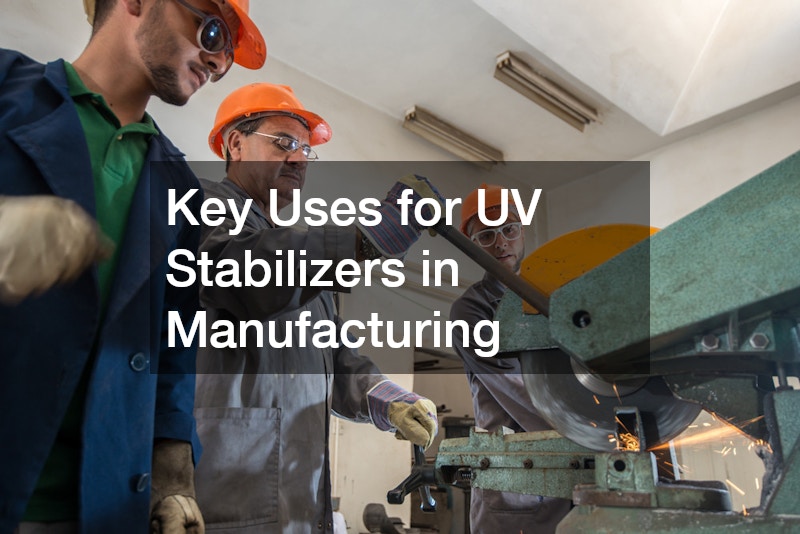Key Uses for UV Stabilizers in Manufacturing

In the realm of manufacturing, UV stabilizers have emerged as vital components in preserving material integrity and extending product life. As various industries strive to improve the durability and functionality of their products, the significance of UV stabilizers cannot be overstated. This article will explore the many diverse applications of UV stabilizers in the manufacturing sector, highlighting their critical role in safeguarding products against the detrimental effects of ultraviolet (UV) radiation.
Overview of UV Stabilizers
UV stabilizers are chemical compounds employed to protect materials from the harmful effects of UV radiation. These specialized additives work by absorbing or dissipating UV rays, thereby preventing the degradation of materials exposed to sunlight. Without these stabilizers, many products would succumb to fading, cracking, or structural weakness when exposed to the elements.
The use of UV stabilizers is particularly essential in the manufacturing of plastics, where prolonged exposure to sunlight can lead to significant material deterioration. Different types of UV stabilizers exist, such as UV absorbers, hindered amine light stabilizers (HALS), and quenchers, each offering varying degrees of protection based on the specific requirements of the product. By understanding the characteristics of these stabilizers, manufacturers can select the most effective combination to suit their needs.
The integration of UV stabilizers into manufacturing processes not only enhances the aesthetic qualities and longevity of products but also promotes sustainability by reducing waste. As a result, manufacturers are increasingly adopting these additives to meet the demands of environmentally conscious consumers. This trend underscores the growing importance of UV stabilizers in the creation of products that can withstand environmental challenges.
Applications in the Automotive Industry
In the automotive sector, UV stabilizers play a crucial role in maintaining the durability and appearance of vehicles. Exterior components such as bumpers, mirrors, and trim are routinely exposed to sunlight, necessitating robust UV protection to prevent premature aging and fading. By incorporating UV stabilizers, manufacturers can ensure that these parts retain their visual appeal and structural integrity over time.
Interior components are equally susceptible to UV-induced damage, making UV stabilizers indispensable for preserving the quality of materials such as dashboards, upholstery, and carpeting. These additives help protect against discoloration and brittleness, ensuring that vehicle interiors remain comfortable and visually appealing throughout the vehicle’s lifespan. Moreover, UV stabilizers contribute to passenger safety by maintaining the structural integrity of critical interior features.
Utilization in Construction Materials
The construction industry also relies heavily on UV stabilizers to ensure the longevity of building materials exposed to the elements. Products such as roofing materials, siding, and window profiles benefit from UV stabilizers, which guard against degradation and discoloration over time. This preventive measure can significantly reduce maintenance costs and extend the overall lifespan of structures.
Moreover, UV stabilizers are essential in the production of outdoor furniture and decking materials, where prolonged sun exposure would otherwise lead to rapid deterioration. By integrating UV stabilizers, manufacturers can provide consumers with products that withstand harsh environmental conditions while retaining their original aesthetic appeal. This capability not only meets the growing demand for robust outdoor materials but also supports sustainable building practices.
Impact on Plastic and Packaging Industries
UV stabilizers have had a transformative effect on the plastic and packaging industries, where product durability and consumer safety are of paramount importance. Amidst the increasing use of plastics in everyday products, UV stabilizers help prevent the degradation and yellowing of plastic materials exposed to sunlight. This protective measure ensures that consumers receive products with consistent quality and longevity.
In particular, packaging materials benefit significantly from the incorporation of UV stabilizers, as they protect sensitive contents from UV-induced chemical changes. Products such as food, cosmetics, and pharmaceuticals maintain their integrity, freshness, and efficacy for longer periods when packaged in UV-stabilized containers. This capability aligns with industry standards and compliance requirements, underlining the essential role of UV stabilizers in safeguarding consumer health
UV stabilizers play an indispensable role in modern manufacturing, providing critical protection against the harmful effects of UV radiation. Across diverse industries, from automotive to construction, plastics, and packaging, these additives have become integral to maintaining product quality and longevity. As manufacturers continue to prioritize environmental sustainability and consumer satisfaction, the application of UV stabilizers in manufacturing processes is poised for further growth and innovation.
.



